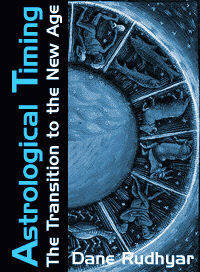 |
| Home | Bio | Art | Music | Literature | Civilization & Culture | Philosophy of Wholeness | Theosophy & Spirituality | Astrology |

ASTROLOGICAL TIMING
The Transition to the New Age by Dane Rudhyar, 1969 First published under the title Birth Patterns for a New Humanity
CONTENTS
PROLOGUE Where Do We Stand Today? PART ONE 1. Three Centuries of Crisis 2. Planetary Cycles 3. Cycles of Relationship PART TWO 4. Stars, Constellations and Signs of the Zodiac 5. From Buddha to Christ The Great Turning Point in Human Evolution Page 1 Page 2 The Beginning of the Piscean Age Page 3 Page 4 Page 5 The Broader Perspective Page 6 Page 7 A 100 BC Starting Point Page 8 Page 9 6. The Structure of the Piscean Age 7. At the Gates of the New Age 8. The Aquarius-Leo Age PART THREE 9. The Zodiacal Earth-Field 10. As We Face the Future EPILOGUE |

CHAPTER FIVE
From Christ to Buddha - 9 If we divide the 2160 period into its three "decanates" (a zodiacal sign of 30 degrees is said to include three decanates of 10-degrees each) we obtain three 720 year sub-periods; and if we begin the Piscean Age at 96 BC the first of these sub-periods ends at the very birth of Islam (the Hegira 623 AD), and the second in 1343. This was the time of the Hundred Years War between France and England which led to Joan of Arc and the birth of the concept of "nation," unknown until then. The Black Plague was ravaging Europe; the Gothic Era was ending, and a spiritual (or occult) movement of rebirth was beginning, which we can associate in Europe with the real Rosicrucian Movement and in Asia with the reform of Tibetan Buddhism by Tzong-Kha-Pa, Humanism was the next stage — the Great Voyages which encircled the globe and led the entrance of the Americas on the planetary stage, the beginning of modern science and the Renaissance. These two dates, or the middle of the seventh and the fourteenth centuries, divide the whole historical process of our (Piscean) Western-Christian civilization into three most significant periods. During the first, we witness the confrontation between the old Roman way of life and the Christian way, between the two great Images, Caesar and Christ. During the second period, the confrontation is between Christianity and Islam, a confrontation which dominates the whole Middle Age culture in Europe, which leads to the Crusades and all that these produced, directly and indirectly. The third period witnesses the third basic confrontation of this Piscean Age pitting Humanism and the spirit of modern Science against a Christianity rent in two by the Reformation (which was in itself an expression of nascent individualism and rationalism). It seems to me that no other date for the beginning of the Piscean Age would offer such a clear-cut and absolutely fundamental division of the historical process, at least in so far as Christendom and European civilization are concerned. However, it is obvious that personal opinions can greatly differ concerning what are the most significant turning-points in the history of a civilization. Except for a man of synthesizing vision like Arnold Toynbee, modern historians (and even more all our college text-books) are myopically searching for small details and records relating the superficial facts of the everyday social or personal life. What is needed in order to grasp the rhythmic process of civilization and of the planet's evolution is the capacity to envision the whole process of human unfoldment in its successive phases. It is to develop what I have named an "eonic" consciousness, attuned to the vast rhythms of the earth, of the continents, of humanity-as-a-whole. This is the "holistic" approach to existence; and the main value of astrology, when properly understood and used, is that it becomes a specialized technique for the development of man's holistic mind. By permission of Leyla Rudhyar Hill Copyright © 1969 by Dane Rudhyar and Copyright © 2001 by Leyla Rudhyar Hill All Rights Reserved.  Web design and all data, text and graphics appearing on this site are protected by US and International Copyright and are not to be reproduced, distributed, circulated, offered for sale, or given away, in any form, by any means, electronic or conventional. See Notices for full copyright statement and conditions of use. Web design copyright © 2000-2004 by Michael R. Meyer. All Rights Reserved. |
 |